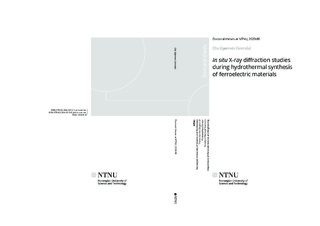| dc.contributor.advisor | Einarsrud, Mari-Ann | |
| dc.contributor.author | Ola Gjønnes Grendal | |
| dc.date.accessioned | 2020-03-11T10:04:06Z | |
| dc.date.available | 2020-03-11T10:04:06Z | |
| dc.date.issued | 2020 | |
| dc.identifier.isbn | 978-82-326-4513-8 | |
| dc.identifier.issn | 1503-8181 | |
| dc.identifier.uri | http://hdl.handle.net/11250/2646349 | |
| dc.description.abstract | Ferroelectric materials are an essential part of our technological society because of their dielectric and piezoelectric properties being utilized in capacitor, sensors and actuators. Nanostructured ferroelectric materials are important for the further development of ferroelectric random-access memory (FeRAM), sensors and actuators in microelectromechanical systems (MEMS), energy-harvesting devices and photocatalysis, and the list goes on. Hence, there is a wide range of possible applications for nanostructured ferroelectric materials meriting further investigations into the synthesis of these materials. Hydrothermal synthesis stands out as one of the most promising synthesis routes for producing nanostructured materials in general, and thus also for ferroelectric materials. Hydrothermal synthesis has the potential for being a cheap, low temperature process yielding high quality materials with controlled size, morphology, composition and even self-assembled hierarchical nanostructures. However, controlled design of synthesis parameters is currently limited to a trial-and-error process and chemical intuition, due to a lack of fundamental understanding of the nucleation and growth processes.
In this work, extensive in situ synchrotron X-ray diffraction studies were utilized to reveal the formation mechanisms of nanosized and nanostructured ferroelectric materials in real-time during hydrothermal synthesis. Two materials were investigated, namely the perovskite BaTiO3 (BT), and the tetragonal tungsten bronze SrxBa1-xNb2O6 (SBN).
For BT, two different titanium precursors were compared, one amorphous TiO2·xH2O precipitate, and one soluble titanium citric acid complex. The in situ studies revealed a fast formation (~ 15 s) of nanocrystalline (~ 15 nm) BT from the amorphous TiO2·xH2O precipitate, and that the reaction kinetics were independent of reaction temperature for the studied temperature range. Nanocrystalline (~ 15 nm) BT also formed from the soluble titanium citric acid complex, but significantly slower, and with a clear temperature dependence on the reaction speed, where increasing reaction temperature yielded faster reactions. Furthermore, with the addition of surfactants, ethylene glycol and sodium dodecylbenzenesulfonate, the crystallite size could be decreased (~ 9 nm) and increased (~ 25 nm) respectively when using the amorphous TiO2·xH2O precipitate as titanium source.
For SBN, a new hydrothermal synthesis route was developed, and the effect of reaction temperature and Sr:Ba ratio in the precursor were investigated. The Sr-fraction in the final product could be tuned by the Sr:Ba ratio in the precursor. Both the Sr:Ba ratio and the reaction temperature were observed to influence the morphology of the SBN particles. Low Sr-fractions and low reaction temperatures promoted the formation of hollow-ended elongated particles that could be described as a type of hopper crystal. With increased Sr-fraction and reaction temperature, cube shaped particles formed by layer-by-layer growth. These differences in growth mechanisms and morphology could be explained based on relative differences in supersaturation, after X-ray total scattering and pair distribution function analysis revealed that the amorphous niobium precursor consist of Lindquist-like ions ([Nb6O19]8-). | nb_NO |
| dc.language.iso | eng | nb_NO |
| dc.publisher | NTNU | nb_NO |
| dc.relation.ispartofseries | Doctoral theses at NTNU;2020:80 | |
| dc.relation.haspart | Paper 1: Grendal, Ola Gjønnes; Blichfeld, Anders Bank; Skjærvø, Susanne Linn; van Beek, Wouter; Selbach, Sverre Magnus; Grande, Tor; Einarsrud, Mari-Ann. Facile Low Temperature Hydrothermal Synthesis of BaTiO3 Nanoparticles Studied by In Situ X-ray Diffraction. Crystals 2018 ;Volum 8.(6)
https://doi.org/10.3390/cryst8060253
This is an open access article distributed under the Creative Commons Attribution License (CC BY 4.0) https://creativecommons.org/licenses/by/4.0/ which permits unrestricted use, distribution, and reproduction in any medium, provided the original work is properly cited | nb_NO |
| dc.relation.haspart | Paper 2: Grendal, Ola Gjønnes; Blichfeld, Anders Bank; Vu, Tuong-Dan; van Beek, Wouter; Selbach, Sverre Magnus; Grande, Tor; Einarsrud, Mari-Ann. Composition and morphology tuning during hydrothermal synthesis of SrxBa1−xNb2O6 tetragonal tungsten bronzes studied by in situ X-ray diffraction. CrysteEngComm 2019 ;Volum 21.(39) s. 5922-5930
Published version avialbale at https://doi.org/10.1039/C9CE01049A
Reproduced by permission of The Royal Society of Chemistry | nb_NO |
| dc.relation.haspart | Paper 3: Grendal, O.G., Nylund, I.-E., Blichfeld, A. B., Tominaka, S., Ohara, K., Selbach, S. M., Grande, T., Einarsrud, M.-A., Designed growth of SrxBa1-xNb2O6 hopper- and cube-shaped nanostructures by hydrothermal synthesis | nb_NO |
| dc.title | In situ X-ray diffraction studies during hydrothermal synthesis of ferroelectric materials | nb_NO |
| dc.type | Doctoral thesis | nb_NO |
| dc.subject.nsi | VDP::Technology: 500::Chemical engineering: 560 | nb_NO |

